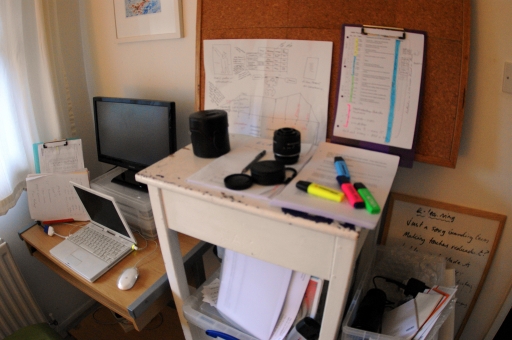There must be industry reports that can give a more current 'state of play' for use of mobile devices (smart phones and tablets in particular) ... though not necessarily confined to use in education.
The Kukulska-Hulme et al 2011 report 'Mature Students using mobile devices in life and learning' may be a recent publication (International Journal of Mobile and Blended Learning Jan-march 2001) but draws its conclusions on research undertaken in between May 2008 and April 2009.
Technologically and in relation to the potential for e-learning a great deal has happened since then.
In industry would we not expect a report, say from Nielsen or Monitor, to have been done in the last six months?
In the technology sector old news is redundant.
By 2009 PDAs were virtually extinct and we were about to experience the launch of the iPad. Since 2009 smart phones have graduated - they're bright in many ways.
Like their users?
Bright people with the means quickly find ways to put these tools to work, extending their reach to their online course, for materials, forums and assessment alerts, to organise their study time around their diary.
FROM THE ABSTRACT
'In today’s global marketplace, educators must know the technology habits and expectations of their students, including those from other countries.' (Kukulska-Hulme et al, 200x1:18)
FROM THE INTRODUCTION
"Learners can be active makers and shapers of their own learning. They should be supported in using technologies of their own choice where appropriate". (JISC, 2009, p.51)
Mobile (as they were) will not necessarily be readily adapted for learning.
Ergonomic, pedagogical, psychological and environmental facts and the issue of cost (Stockwell, 2008)
More widespread adoption by students and teachers is likely to follow. (ibid 2011:19)
A convenient and powerful tool for learning.
In an age when "communities are jumping across technologies" as needs and trends evolve (Wenger, 2010), educators and researchers also have to stay informed about how learners use personal technologies as members of communities that may be social, work-related or educational'.
Decreasing institutional control
Jones, Ramanau, Cross and Healing (2010) have critiqued the 'new generation' arguments, concluding that "overall there is growing theoretical and empirical evidence that casts doubt on the idea that there is a defined new generation of young people with common characteristics related to their exposure to digital technologies through-out their life (p.6)
Notable minorities
- Internet to download or upload materials (major minority)
- Contribute to blogs and wiki and engage with virtual worlds (ibid p.21) (minor minority)
'We consider that learners who use handheld mobile devices (e.g., their phones and mp3-players) to support their learning constitute a minority at the present time. We agree that their age seems less important than their position as early adopters and instigators of change through their influence among their peers and through their networks'. (2011:19)
Students registered on such programmes would be particularly strong. (Distance learning).
The sample was purposive.
For key areas:
- Learning
- Social Interaction
- Entertainment
- Work
- Interplay between them (Kukulska-Hulme & Pettit, 2009)
'Learning' is not an unambiguous term ... instead of the double negative why not 'learning is an ambiguous term'.
Does the rhetorical device of the double negative make the statement less assailable?
'We were interested in gathering data that might challenge the still widespread opinion amongst educators that mobile devices are of little use for academic study. Activities such as web browsing, reading e-news, article reading, book reading, and note taking are valued in the academic world but often considered implausible on handheld devices.' (2011:20)
Until more recently that his study which was carried it 2009.
Since the survey was developed, other devices including notebook computers and e-book readers have become popular, making it even more difficult to draw boundaries between 'handheld learning', laptop learning' and 'desktop learning'. (2011:21)
As if such a distinction was ever necessary? They are all computers, just different sizes, affordances and capabilities.
I liken this loss of boundaries, or the blurring, to drops of ink in a tank of water that gradually swirl about each other and merge.
We are able to highlight some differences that became apparent
Conversations with their students
Students do not always realise the potential of new tools and this is an aspect where educators can help (Trinder, Guiller, Margaryan, Littlejohn & Nicol, 2008)
Questions covered:
- About yourself
- Use of mobile devices
- Being part of groups and communities
- Specific uses for mobile devices
- Mobile devices for learning
- Open questions enabled participants to write a response in their own terms.
A total of 270 students complete the questionnaire.
Over all the report notes that:
- There are receptive, productive and communicative uses
- Respondents are using mobile devices to capture ideas and experiences
- Mobile devices have a useful function as tools that remind he user about what she/he has to do.
- Respondents make use of a range of applications for informal learning.
- One function of games is to fill gaps in the day.
- Some respondents appear to be drawing boundaries around disparate uses
- The mobile phone features as an alternative means of communications and to sport physical mobility, e.g. as an alternative to having a land line or when work involves travelling.
RE: LEARNING
- Contact with others
- Access to information and answers
- Reading e-Books
- Listening to Podcasts
- Scheduling
RE: MORE UNUSUAL USES:
- Recording one's voice
- Replay on iPod
- Taking photos
- Contacting experts in other fields
- Uploading notes to blog
- Facebook
- Windows Live Messenger
- MSN
- Skype
- Language learning
- Finding information
- Headphones to shut out distractions
- Productive activities
'Reported benefits of using mobile devices to be part of groups or communities include spontaneous communications, flexibility, speed, stimulation and use of technology to cope with changing arrangement'. (2011:27)
27 Distinct uses of mobile devices (ibid, 2011:28)
The three most intensive uses are very clearly sending text messages, browsing websites and listening to music ... and reading e-news. (2011:28)
Responses included well established advantages such as convenient access to information or to the Internet and the ability to contact people whenever needed. Specific new/innovative aspects notes by respondents included (2011:29):
- Permanency of taking notes: paper is easily lost
- Multipurpose; you can take your work/entertainment with you
- Can combine work with a run with listening to a podcast
- Podcasts give access to unique historical/scientific content
- Suits auditory learners
- Closer relationship between students and teacher
- Multimedia in one small device is a timesaver for teachers
- Instant documentation of whiteboard notes
- Taking photos of overhead slides
- Help with learning disabilities
- Alternative news source/breaking news/immediate first hand reports
- Helps maintain a public diary with a community dimension
- Quick way to learn
- Gets you outdoors
- Field trips become more fruitful and challenging
DISCUSSION AND REFLECTIONS
Mobile devices are shown to support informal; and community learning
While the predominant se for mobile devices is communication, it seems that other aspects of social interaction can benefit, such as the ability to share media between mobile devices directly or blended across other social networking technologies like Facebook.
The research confirms the global popularity of SMS, browsing websites, listening to music, taking photographs and making notes. It also highlights that reading e-news and listening to podcasts are relatively frequent activities among some students, and that article- and book-reading, once considered implausible on handheld devices, are popular among a minority. (2011:30)
What is interesting is that there appear to be many ways in which users are employing technologies to generate products. Bruns (2005) coined the term 'produsers' to denote both of these approaches. One survey shows that mobile devices are enabling users to create resources for teaching purposes, write blogs to keep their friends up to date with events, take and distribute photos and videos, and make and take notes and recordings'. (2011.31)
New practices compared to old studies (2007/2009) include:
- Using apps on the phone including Facebook and MSN
- Using GPS to find places
- Watching movies, TV, shows, vodcasts
- Listening to audio books, podcasts
- Being part of microblogging communities e.g. Twitter
- Browsing websites
- Using location-based services, e.g. to find nearby taxis, banks, restaurants, etc.
- No longer having a land line.
- Mobile device use is a fast-changing field that reflects rapid social changes as well as the increasing availability and smarter marketing of new devices. (ibid, 2011:32)
Micro-blog - are becoming more widespread, and we would expect these uses to figure more prominently in the future. (2011:32)
Slate devices Apple iPad.
Several universities now offer 'apps' for smartphones using platforms such as Campus M.
‘Our findings indicate that institutions planning to offer mobile apps should build on the existing preferences of students for social communication. Listening to audio, watching video and reading short texts if the apps are successfully to enhance the learning experience’. (2011:32)
When students are offered appropriate mobile resources then they will use them. (2011:32)
We agree with Kennedy et al (2008) that 'an evidence-based understanding of students' technological experiences is vital in informing higher education policy and practice.' (p. 109)
Pressures of study and assignment deadlines lead them to seek effective solutions to immediate needs on the go. (2011:33)
Avoid a 'proadoption bias'
‘Furthermore, since the use of a mobile device represents a new technological means of reading books, articles and news, this might have an impact on how, and how much, students read, however further research would be needed’. (2011:33)
The landscape of mobile devices has changed since our survey with some devices (standalone PDAs) becoming almost extinct and others (handheld GPS) endangered. (2011:33)
In favour of smart mobile phones and tablet devices.
REFERENCE
Bruns, A. (2005) 'Anyone can edit': understanding the produser. Retrieved from http;//snurb.info/index. php?q=node/s86
Conole, G (2007) Describing learning activities: Tools and resources to guide practice. In Beetham, H, & Sharpe, R (eds.), Rethinking Pedagogy for a Digital Age: Designing and delivering e-learning (pp.81-91) London, UK: Routledge
Kukulska-Hulme, Agnes, John Pettit, Linda Bradley, Ana A. Carvalho, Anthony Herrington, David M. Kennedy, and Aisha Walker. "Mature Students Using Mobile Devices in Life and Learning." IJMBL 3.1 (2011): 18-52. Accessed (May 22, 2011)
JISC. (2009). Effective Practice in a Digital Age: A guide to technology-enhanced learning and teaching. Retrieved from http://www.jisc.ac.uk/publications/programmerelated/2009/effectivedigital-age.aspx
Rogers, E.M. (2005) Diffusion of innovations (5th ed.) New York, NY: Free Press
Jones, C.R., Ramanau, R., Cross, S., & Healing, G. (2010) Net generation or Digital Natives: Is there a distinct new generation entering university? Computers & Education, 54(3), 722-732. doi. 10.1016/j.compendu.2009.09.022
Stockwell, G (2008) Investigation learner preparedness for and usage patterns of mobile learning. ReCALL, 20(3), 253-270. doi.10.1017/S058344008000232.
Trinder, K., Guiller, J., Margaryan, A., Littlejohn, A., & Nicol, D. (2008). Learning from digital natives: bridging formal and informal learning. Retrieved from http://www.heacademy.ac.uk/assets/York/documents?LDN%20FINAL%eport.pdf
Wenger, E (2010). SIKM community presentation online. Theme: Rethinking Ourselves (KM People) as Technology Stewards. Retrieved from http://technologyforcommunities.com



